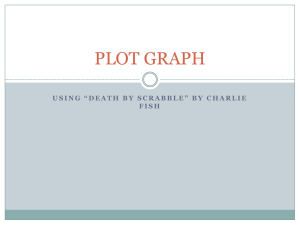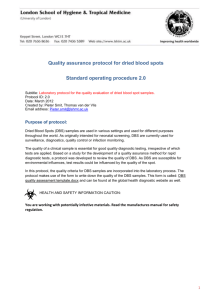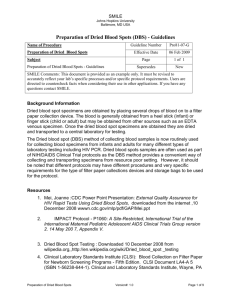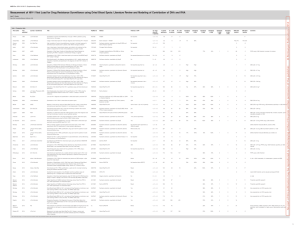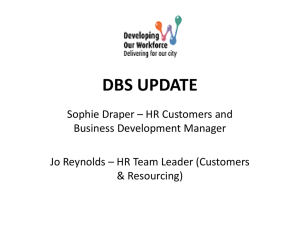DBS
advertisement
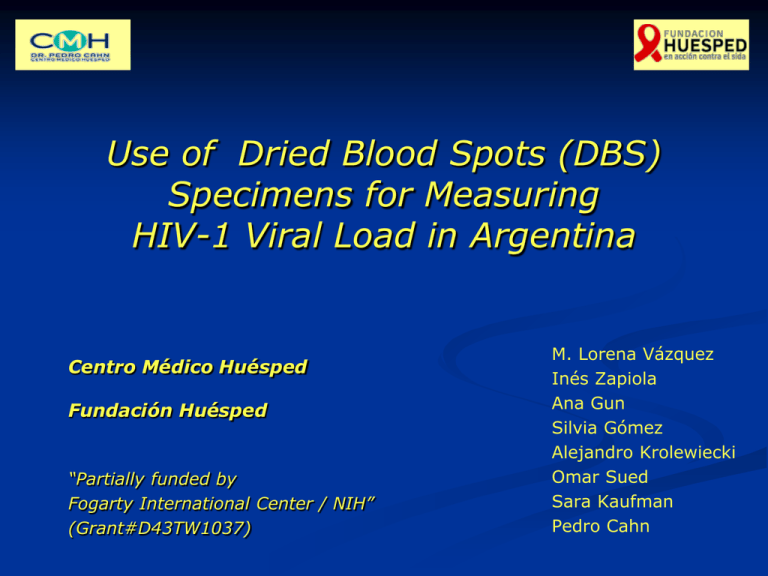
Use of Dried Blood Spots (DBS) Specimens for Measuring HIV-1 Viral Load in Argentina Centro Médico Huésped Fundación Huésped “Partially funded by Fogarty International Center / NIH” (Grant#D43TW1037) M. Lorena Vázquez Inés Zapiola Ana Gun Silvia Gómez Alejandro Krolewiecki Omar Sued Sara Kaufman Pedro Cahn What are DBS (Dried Blood Spots)?: Whole blood collected and dried on filter paper About DBS and HIV, we know… DBS are useful for qualitative detection of HIV antibodies, DNA and RNA. Samples dried on filter paper remain stable for HIV-1 RNA detection. DBS are currently used to determine HIV-1 viral load in some African countries. CDC Recomendations for DBS: Dried blood spot specimens can be shipped or transported by mail or other carriers with no reasonable expectations of occupational exposure to blood or other potentially infectious material. "Universal precautions" are to be followed in collecting and preparing these specimens for shipment. Standard filter paper collection kits should be enclosed and sealed in high quality paper mailers ideally, extra-strong, tear-proof, air-permeable, and water-resistant envelopes. These steps provide reasonable safety against occupational exposure and maintain optimal specimen integrity. DBS can be shipped by regular mail or other carriers DBS must be enclosed in high quality paper mailers (htpp://www.cdc.gov/od/ohs/biosafety/driblood.htm) Why Dried blood spots? Laboratory tests are essential for monitoring the efficacy of antivirals and for the optimal management of treatment. Trained personnel Centrifugation of samples plasmatic Storage of plasma in cryotubes, in freezers viral load Transport on dry ice High transportation costs HIV-1 Such conditions are often unsuitable for resource-limited countries In Argentina HIV-1 viral load costs around USD 74 Shipment of a sample from Orán (Salta) to Buenos Aires by a private courier costs around USD 60 (an additional cost equivalent to the 75% of the value of the viral load) Hypothesis: In resource-limited settings, dried blood spots represent an easy and suitable alternative to plasma for the determination of HIV-1 viral load. Objective: To validate a real-time determination of HIV-1 RNA viral load in dried blood spots by comparison with standard plasma viral load. Study design: 82 HIV-1 infected patients Whole blood Whole blood to to get DBS get Plasma Storage of plasma at -70ºC 1 week Viral load Storage of DBS at room temperature vs 1 week Viral load At the laboratory, patients were asked to authorize the use of their samples for this study and, in this case, they signed a consent. Population n= 82 patients Mean Age 38 years (9-55) Mean Hematocrit 40 % (25-49) Mean CD4 (total) 424 cells/ml (0-1257) Mean CD4 (%) 23 % (0-56) On treatment 38 (46%) Without treatment 44 (54%) Specimen Preparation: We take two whole blood samples in EDTA tubes. Plasma: 1000 ul. Cryopreserved until being used PLASMATIC Viral Load Dried blood spots: 6 spots x 50 ul each one. (Whatman 903® Collection Paper) Air dried overnight. Stored at room temperature in specimen collection bags with dessicant during one week. DBS Viral Load DBS: Pre-Extraction Procedure Cut out the complete blood spots (2 spots of 50 ul per extraction) from the filter using a pair of scissors. Add the spots into a Nuclisens® Lysis Buffer 2 ml tube. Incubate the tubes on a roller mixer for 2 – 3 hours at room temperature. Centrifugate the tubes during 15 seconds at 1500 g to spin down the fluid. Transfer the lysate for nucleic acid extraction into a new tube. RNA isolation (Nuclisens® miniMagTM) Addition of an internal calibrator Sample + Internal calibrator Incubation with magnetic silica Washings Elution HIV-1 viral load (Nuclisens® HIV-1 EasyQ) At the same time: Isothermical molecular amplification at 41ºC Detection of the amplified product by “molecular beacons” Results: Number of undetectable and detectable cases in both types of specimens 60 50 40 Plasma DBS 30 20 10 0 <50 copies/ml >50 copies/ml N Min Max Mean Std. Dev Median log plasma VL 47 2.43 5.7 4.42 0.73 4.30 0.93 log DBS VL 47 2.49 5.7 4.19 0.82 4.28 1.28 Dif log(Plasma-DBS) 47 -1.18 1.1 0.23 0.48 0.29 0.67 1 copy/ml = 1 IU/ml IQ Correlation between both types of specimens Spearman`s Rho 0.946 P<0.001 n=47 VL>50 copies/ml 0.810 P<0.01 n=31 VL<50 copies/ml Indetectable by two methods 6.0 5.0 4.0 3.0 Averages 2.0 Log VL Plasma Bland Altman´s Analysis log plasma VL – log DBS VL n=82 2.0 3.0 4.0 Log VL DBS 5.0 6.0 Results according to range of values 45 4 samples 30 25 20 15 >50 in plasma 35 <50 IU/ml 31 35 50-400 3 1 10 401-3000 6 4 5 >3000 42 42 0 <50 51-400 401-3000 Copies/ml >3000 n DBS Total 82 82 n Plasma SENSITIVITY: 92.2% SPECIFICITY: 100% POSITIVE PREDICTIVE VALUE: 100% NEGATIVE PREDICTIVE VALUE: 88.6% 4 samples n DBS <50 in DBS n Plasma 40 Conclusions: 1. This study demonstrates that DBS performed well as compared to plasma in monitoring viral load. 2. Since no false positive and only 4 false negatives were found (all with VL<3000 copies/ml), we conclude that DBS is a simple and cheaper strategy that may be considered as an alternative to standard VL quantification in resource-limited settings. 3. Although sensitivity was reduced in samples with low – level viremias, DBS would be capable of identifying patients in need of switching to second-line ART. Acknowledgements: All the patients who contributed with this study Fogarty AIDS International Training and Research Program Fundación Huésped bioMerieux Argentina "We have no solutions in our hands to the world's problems. But to face the world's problems we have our hands." P. Menapace Thank You very much!!!
